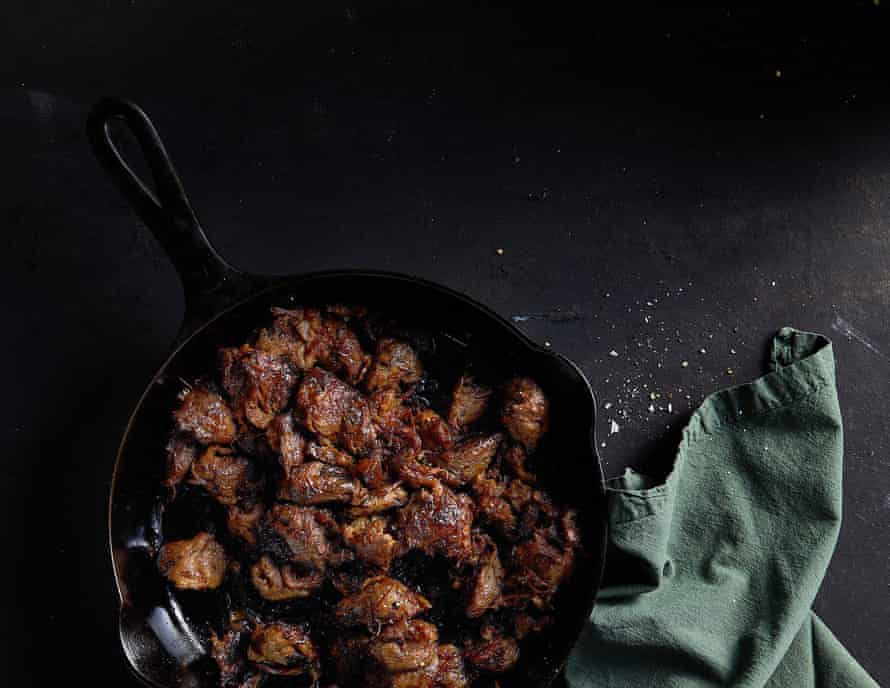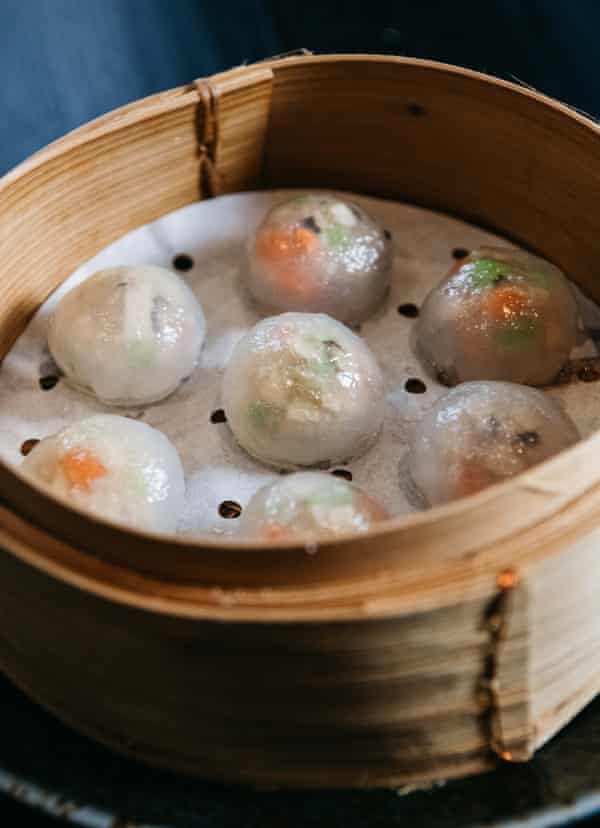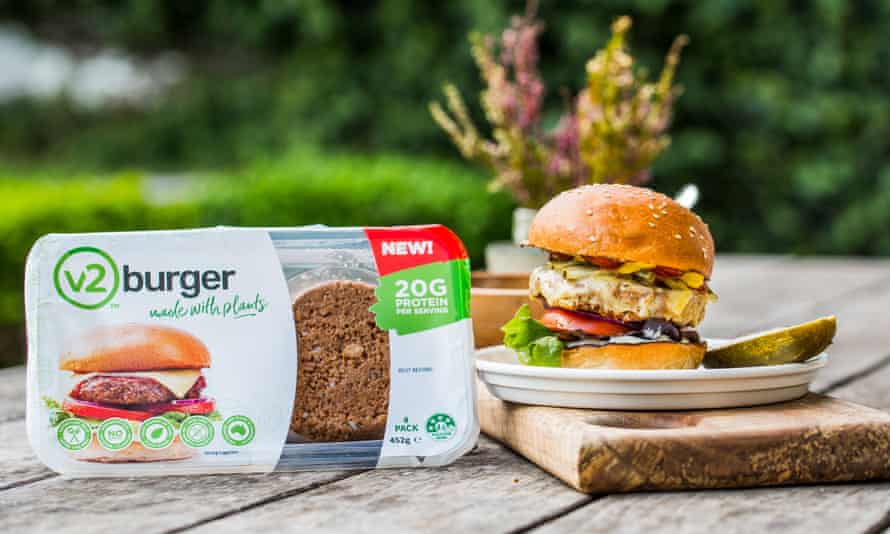How the sausage gets made: the serious business of fake meat
Australia’s plant-based meat market is booming, with increasingly sophisticated production techniques aimed at earning a place on carnivores’ plates

On an industrial road in Coburg, in Melbourne’s north, there’s a tale of two facilities. Both are filled with razor-sharp industrial slicers, grinders, hundreds of long needles to pump marinades, and machines that fill and twist silky alginate casings, made from refined seaweed, to produce up to 400 sausages a minute.
One turns out beef patties and butterflied lamb legs, mainly destined for national supermarkets. The adjacent, newer plant has almost identical equipment but no meat at all.
Both are owned by Norfolk Foods, a firm that has specialised in meat processing and wholesale for more than a decade. In 2019, the company built the second facility dedicated solely to plant-based protein alternatives, under the brand Rogue Foods.
Chris Nicklin, the firm’s general manager, says a growing appetite for meat alternatives made the expansion a logical choice. So far, Rogue has commercialised a plant-based ham that they supply to pizza makers.
“There’s a big chunk of our customer base that are looking for something different,” Nicklin says. “You’ve got to be pretty blind to not try and cater for that.”
Whether it’s fast food chains, fine dining or the refrigerated aisles in supermarkets, animal-free meat alternatives have beefed up their game in recent years. Hungry Jack’s, Nando’s and Grill’d all offer plant-based burgers. In June, the celebrity chef Neil Perry announced a partnership with v2food to serve meat-free dishes at his new restaurant in Sydney’s salubrious Double Bay. Grocery sales of plant-based “meat” products in Australia are growing rapidly – they increased by 46% in the 2019-20 financial year, according to a report by nonprofit thinktank Food Frontier.

In three years, the industry has doubled in jobs, manufacturing revenue, and players on the market – there are now more than 20 Australian alternative meat brands with products in major retailers.
Thomas King, Food Frontier’s chief executive, says both supply and demand will only continue to grow.
King cites “the world’s top authorities on agrifood systems, sustainability [and] economic development”, saying “diversifying global protein supply will be essential to meet rising demands worldwide”.
Their case is clear: a major 2018 study found that avoiding meat and dairy products is the single biggest way an individual can reduce their environmental impact on the planet.
Around 12% of Australians, as of 2019 statistics, are wholly or mostly vegetarian – a proportion that has risen steadily since 2012.
But Prof Michelle Colgrave, a protein scientist at the CSIRO, says a bigger change is the growing number of people who consider themselves flexitarians or reducetarians. Around one in three Australians are consciously reducing their meat intake, usually for health or environmental reasons.
“Typically, 70% of the calories that we consume comes from around 12 plants and five animals,” Colgrave says. A more diverse diet is better for health and “at the same time, [it] will help with biodiversity on our planet”.
How to fake meat
Traditional plant-based proteins include wheat, soy and pea. There are newer products made from pulses – including chickpea, fava bean and lupin proteins – and, less commonly, from aquatic sources such as duckweed and spirulina.
But how does one approximate the satisfying experience of biting into a fat-marbled piece of meat, with its yielding flesh and rich umami flavours?
To mimic meat, Colgrave says “you’re going to need those textural components, you’re going to need some of those savoury flavours, and then you’re going to want the cooking experience”.
Meat alternatives can be made with a mixture of both protein and fat, she says, to emulate the combination of muscle and adipose tissue in animal meat. They often brown like meat does when seared, as a result of Maillard reactions – chemical reactions between amino acids and sugars – that give rise to complex flavours.
Then, Colgrave says, there’s also how the food breaks down in the mouth – a specific field of science, called food tribology, studies factors including slipperiness, roughness and mouth-coating characteristics.
Most meat alternatives on the market are made from textured vegetable protein, which is turned into mock mince in sausage and burger-style products, says Nicklin.
Other textures are harder to replicate. At the Rogue Foods facility, a machine called an extruder uses high temperature, moisture and mechanical stress to alter plant proteins. This process helps with “mimicking and replicating muscle texture and fibres”, he says. “We’re doing a lot of playing around with chicken pieces and diced beef stir fries.”
Other companies, such as Fable Food Co, aren’t aiming for replication. “We’re not necessarily trying to make the burger patty start out red, and when you cook it, turn brown,” says Michael Fox, the company’s co-founder and chief executive.

Fable’s products, made from shiitake mushrooms, are sold in major retailers and also dished up in 400 restaurants around Australia. Though Fox says the result has both umami and a “stringy, slow-cooked meaty texture” the “goal is to make mushrooms taste amazing and to help people transition away from meat”.
Starters and cultures
For those who can’t forego the taste of real meat, could a lab-grown alternative provide the solution? Cellular agriculture, once the territory of science fiction, promises to produce the meats we know and love without the environmental impacts – if you can stomach the idea.

Vow Foods, a Sydney startup, is making meat from the stem cells of 13 animal species, including alpaca and water buffalo, in addition to traditional livestock animals. It unveiled dumplings with a filling grown from kangaroo cells in 2019, and is planning on launching its first commercial product in Singapore in 2022, where regulators have already approved cell-based meats.
Vow co-founder Tim Noakesmith likens the cell lines for cultured meat to a yeast starter for bread – “we grow [it] into millions if not trillions of cells” which are integrated with plant proteins to produce the end result.
For now, cultured meat is far more expensive than the real thing – chicken nuggets made by US firm Eat Just will set you back $23, sold at a loss – and also has consumer wariness to contend with. Some animals, albeit in far lower quantities, still die to produce it.
But not all cultures rely on animal cells. Eden Brew – which, like v2food, is a CSIRO spinout company – is set on developing cow-free dairy products. Using a process known as precision fermentation, Natalie Curach, the firm’s chief scientific officer, says they can produce the casein and whey proteins found in cow’s milk using a modified common yeast.
“We brew yeast just as you would see in a craft brewery, and the soup that comes off is a blend of all the proteins that you’d find in milk.”
The proteins are then purified, diluted and mixed with other components such as fats, some also grown from yeast, to mimic the mouthfeel of milk. Co-founder Jim Fader anticipates their first brewed drink, planned for launch next year, will retail on the premium end of the milk spectrum, at around $3.50 for a two-litre bottle.

The meaning of meat
Despite the popularity of meat alternatives, they aren’t likely to do away with livestock animals any time soon. Plant-based meat products account for less than 1% of the global meat market. Food Frontier predicts that by 2030, Australian consumers will be spending $3bn on plant-based products; in 2018-19 domestic sales of red meat alone totalled $11.3bn.
“We need both, new protein options alongside traditional ones,” King says.
He believes cultured meats and precision fermentation change how meat and dairy products are framed. “Those foods are no longer defined by their composition, but instead by structure, taste and their role on our plates.
“People are becoming increasingly aware of the impacts of our food choices, ecologically and health wise. But at the same time, meat plays a significant role, economically [and] culturally.”
Colgrave agrees. The demand for meat internationally is increasing with a growing middle class in parts of Asia and Africa, she says. “There’s opportunities in the red meat space to deliver premium protein into those markets.” Plant-based products, she says, “can be complementary to those”.

Despite the small market share of alternative proteins, some meat producers are angry. Their beef? The changing definitions King refers to – that the labelling of plant-based products don’t distinguish them clearly enough from “real” meat.
A Senate inquiry on the definition of meat began this week. It is chaired by the Queensland senator Susan McDonald, who told the committee she had spoken to people who had bought plant-based products “in confusion because of the descriptors on the packaging”.
The ACCC, Australia’s consumer regulator, made a submission to the inquiry stating it had received “very few reports about consumers misled by the labelling used for plant-based substitute products. The few we do receive are reports from consumers and industry stakeholders in sectors that produce meat or dairy products raising concern that plant-based substitute products use animal product related descriptors (eg ‘meat’; ‘burger’; ‘milk’).”
Jason Strong, the managing director of Meat and Livestock Australia, doesn’t anticipate plant-based products will affect the demand for red meat. “There’s no question there’s a bunch of interest in these new products,” he says. “And we’ve seen quite a lot of interest in businesses trying to supply into that sector.”
But Australia exports about 75% of its red meat, and Strong says supply is barely keeping up with demand.